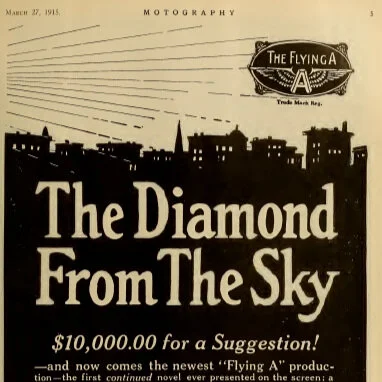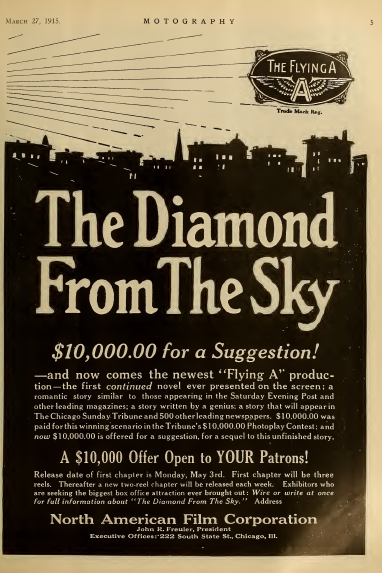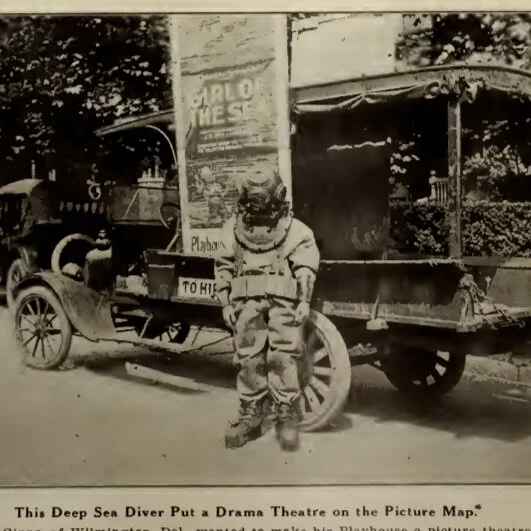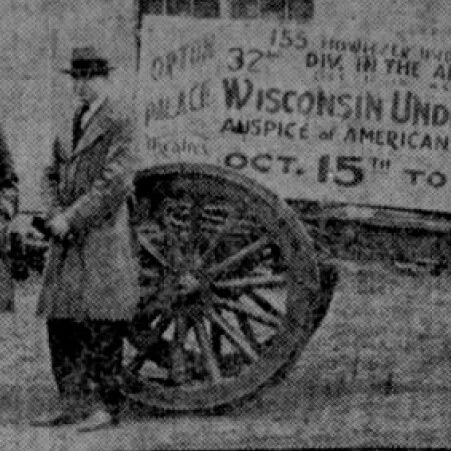The Movie Serial
Previously, I’d posted about the visionary independent film mogul, John R. Freuler. Freuler made a number of contributions to the early film industry: he pioneered the vertically-integrated film production/distributing model; he birthed the “star system” and relentlessly promoted it in trade press; he organized industry lobbying “against censorship” (or alternatively, for keeping censorship in the hands of company board members); he also pioneered the US government/film industry partnership which flowered in WWI and beyond.
In the early ‘teens, the film industry shifted away from short one or two reel films and branched out into “feature” productions, which spanned several reels and were vastly more expensive to make. This is the time in the industry when financial backing from New York City (in particular) really made the difference between failure and success. Freuler was forward-thinking in this arena too: he championed the serial, a multi-part story where each installment stretched only a reel or two, but regularly-issued installments would continue for months. Serials enjoyed sustained interest (and economical use of sets) coupled with the cashflow-friendly single reel format.
Serials produced by Freuler included: “The Diamond from the Sky” (1915, a weekly release spanning 30 weeks); a two-reel per episode “Sequel to the Diamond from the Sky” (1916, four weeks) ; and a two-reel per episode war serial titled “The Secret of the Submarine” (1916, weekly, 15 weeks).
These serials were accompanied by serialized novel installments printed in Chicago-based newspapers— a practice which helped sustain viewer interest outside of the theater. Additional promotion came through newspaper-based contests. The as yet unnamed “Diamond” project was advertised through a contest in the Chicago Tribune which called for screenplay submissions from anyone and everyone. As time went on, Mutual would focus on submissions from professional writers (particularly newspapermen).
From Motography magazine, March 27th 1915.
A similar contest was held for the script of “The Secret of the Submarine”; this time a war correspondent named E. Alexander Powell was the lucky winner. Unfortunately, Powell had plagiarized the story from a previously published work by another war correspondent named Richard Barry — Freuler had to settle the $100,000 lawsuit out of court.
IMDb image of typical “The Secret of the Submarine” advertising, June 1916.
Motion Picture News, May 6th 1916. Earlier advertisements for “Secret of the Submarine” championed E. Alexander Powell and his submarine credentials.
This setback didn’t dampen Mutual spirits, however, and partnerships between the Chicago Tribune and other newspapers were a regular feature of Freuler’s strategy for advertising movie serials.
While Freuler was forward thinking in his newspaper/movie serial combo, he was not entirely original. He probably hit on this idea during one of his European tours. In German-speaking areas newspaper/movie serial advertising partnerships had been around since early 1913. One example:
Grazer Volksbatt, May 27th 1913. “The Adventure of Lady Glane, after the famous novel serialized in the “Berliner Tagblatt” (newspaper)”.
The German film in the advertisement, “The Adventure of Lady Glane”, a film in three acts, was produced by the Deutschen Kinematographischen Gesellschaft. This company worked with the well-connected “Berliner Tagblatt” newspaper to bring a serialized print romance novel to life on screen. The advantage to this arrangement was that the newspaper got advertising from the film, and vice versa. I haven’t seen evidence that a German film company ever used newspaper-based contests as a vehicle to hype a film; but this was a classic American gimmick used by ad-men in the 1910s and 1920s. Throughout his film career Freuler would adopt and adapt European film business practices for American markets.









